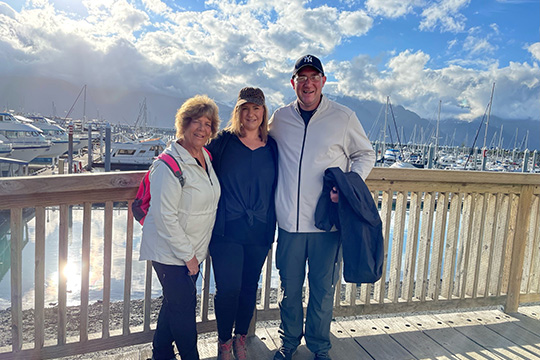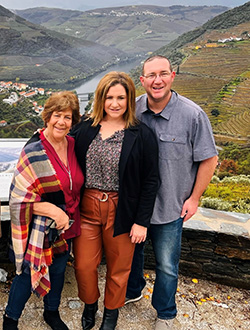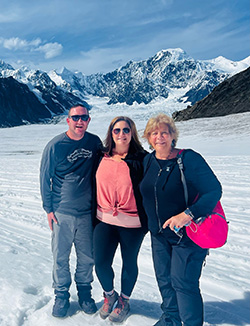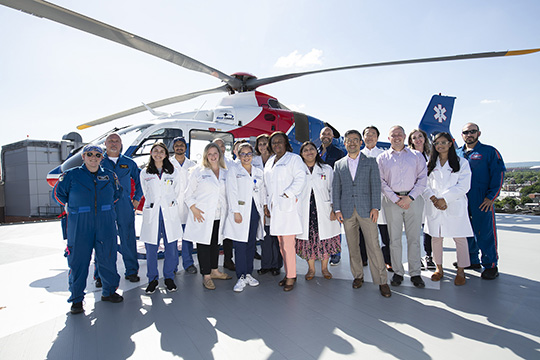"Time is Brain,” isn’t just a catchy tagline, Dr. Rybinnik notes. Parts of the brain can die if they do not receive proper blood flow for too long

The slogan “Time is Brain,” is often used to educate individuals about the importance of acting quickly when they think someone may be having a stroke. It definitely applied in the case of Rosemary Bowen when she suffered a stroke last February in her Forked River home.
Because Rosemary shares her home with her two adult children who both acted immediately when they recognized the signs, she received the immediate, expert care she needed at Robert Wood Johnson University Hospital (RWJUH) and Community Medical Center (CMC), both RWJBarnabas Health facilities. This helped her avoid severe, life-altering effects from her stroke. She is now back at work and well on the road to recovery.
“I never thought in a million years that I would have a stroke,” Rosemary explained. “For 72, I am in pretty good health. My father passed away because of his heart and I thought if something was going to get me, that would be it.”
Igor Rybinnik, MD, Associate Professor in the Division of Stroke and Neurocritical Care at Rutgers Robert Wood Johnson Medical School (RWJMS) and an Attending Neurologist at RWJUH, whose team cared for Rosemary, believes the quick and decisive action by her children was essential to her survival and recovery.
 “Rosemary’s family was instrumental in recognizing her stroke symptoms and activating 9-1-1,” Dr. Rybinnik notes. “As a result, she was transported to the appropriate center and received stroke therapies rapidly, allowing us to preserve as much brain function as possible. She has recovered remarkably well, allowing her to return to her active lifestyle.”
“Rosemary’s family was instrumental in recognizing her stroke symptoms and activating 9-1-1,” Dr. Rybinnik notes. “As a result, she was transported to the appropriate center and received stroke therapies rapidly, allowing us to preserve as much brain function as possible. She has recovered remarkably well, allowing her to return to her active lifestyle.”
“Time is Brain,” isn’t just a catchy tagline, Dr. Rybinnik notes. Parts of the brain can die if they do not receive proper blood flow for too long.
“The ‘Time is Brain’ mantra is exceedingly important in the treatment of stroke because it is estimated that roughly two million neurons die per minute when they are deprived of blood flow,” Dr. Rybinnik explains. “So, if a patient experiences a sudden blockage of a brain blood vessel, the sooner they present with their symptoms to the emergency department the quicker we can deliver stroke therapy, and the higher the chance of preserving the brain.”
 Just before suffering her stroke, Rosemary was recovering from a severe case of the Norovirus that had impacted the state last winter. She was just starting to feel better and “like herself again.” Then at about 4 a.m. on Sunday, February 19, she woke up to use the bathroom, but couldn’t walk. She slid off the end of her bed and remained on the floor unable to move until her daughter and son ran into her room to check on her.
Just before suffering her stroke, Rosemary was recovering from a severe case of the Norovirus that had impacted the state last winter. She was just starting to feel better and “like herself again.” Then at about 4 a.m. on Sunday, February 19, she woke up to use the bathroom, but couldn’t walk. She slid off the end of her bed and remained on the floor unable to move until her daughter and son ran into her room to check on her.
Her daughter Rachael noticed that her mother’s speech was slurred, her face drooped and she kept leaning to her left – the side of her body that was impacted by the stroke. Rachael called 9-1-1 immediately and the local rescue squad arrived within minutes to rush her to CMC in Toms River, a designated Primary Stroke Center accredited by The Joint Commission.
“As a Primary Stroke Center, we pride ourselves in providing ongoing education to our staff and local EMS squads,” said Amanda Leibowitz, BSN, RN, CMC Stroke Program Coordinator. “Our teams are highly trained in identifying stroke immediately in the field and on arrival prompting the direct activation of our Stroke Team. The collaboration between CMC and RWJUH’s Comprehensive Stroke Center to quickly assess patients that are eligible for neurointervention is key to achieving successful patient outcomes.”
While at CMC, doctors performed a CT Scan and consulted with a neurologist via telehealth technology. After reviewing the scan, the neurologist identified a blood clot in Rosemary’s brain and determined that she would need to be transferred immediately to RWJUH in New Brunswick to have it removed via thrombectomy. RWJUH is certified by The Joint Commission as an Advanced Comprehensive Stroke Center due to its advanced neurointerventional, neurosurgical and neuro critical care capabilities to handle complex and delicate procedures like the one Rosemary required.

Rosemary was airlifted to RWJUH via the RWJBarnabas Health Life Flight helicopter. She arrived at RWJUH within a half hour and was rushed into the Special Procedures Unit where a team led by Gaurav Gupta MD, FAANS, FACS, Associate Professor of Neurosurgery at RWJMS and RWJUH and Co-Director, Cerebrovascular and Endovascular Neurosurgery at RWJBH, successfully removed the clot via thrombectomy. By 8:30 a.m. that same Sunday morning, Rosemary was in her room on the highly specialized Neurocritical Care Unit and already able to speak with her daughter and caregivers.
“They showed me a scan of my brain and I was able to see the image of where they went in and took the clot out,” Rosemary recalled. “I was very fortunate that my son and daughter were there and everyone acted quickly.”
In addition to the fast actions of her children, seamless collaboration between the stroke programs at RWJUH and CMC, as well as the Life Flight emergency transport team, played a key role in Rosemary’s successful outcome.
“Collaboration between institutions is exceedingly important. There are many hospitals that are able to assess a patient with stroke and deliver clot-busting therapy, but there are fewer hospitals that have the capability of delivering surgical clot retrieval (mechanical thrombectomy),” Dr. Rybinnik says. “Patients may need to be emergently transferred to receive thrombectomy. That transfer is accomplished through the collaboration between the RWJBH Life Flight team and the stroke teams at CMC and RWJUH.”
While at RWJUH, Rosemary was able to dress herself, eat on her own, and walk on the care unit with some supervision. She returned home in four days and was back at work in her job as a paraprofessional for special needs students at her local K-4 elementary school within five weeks. She is currently completing physical therapy to regain strength and motor skills on her left side.
“It’s funny, but I’m Italian and we’re known for talking with our hands a lot,” Rosemary said. “My daughter said to me, ‘Mom – you’re only using your right hand!’ So, I’m working to get back to talking with both hands!”
All kidding aside, returning to work and the children she helps every day was a driving factor in her recovery.
“Going back to work was everything,” Rosemary notes. “I have been doing this for 26 years and have been at the same school for 24 years – I could’ve retired by now if I wanted. I love the kids. They definitely keep you young. There were so many cute get-well cards on my desk when I returned to work. I feel like I am the grandma there. The teacher is young enough to be my daughter and the paraprofessionals are all younger. I have had the same kids for several years in a row and you really get to know them and their parents. You become family.”
If you notice signs or symptoms of a stroke in yourself or someone else, using the BE FAST Scale, call 9-1-1 as quickly as possible.
BE FAST:
B - Balance
Is the person suddenly having trouble with balance or coordination?
E - Eyes
Is the person experiencing suddenly blurred or double vision or a sudden loss of vision in one or both eyes without pain?
F - Face Drooping
Does one side of the face droop or is it numb? Ask the person to smile.
A- Arm Weakness
Is one arm weak or numb? Ask the person to raise both arms. Does one arm drift downward?
S - Speech Difficulty
Is speech slurred, are they unable to speak, or are they hard to understand? Ask the person to repeat a simple sentence like, “The sky is blue.” Is the sentence repeated correctly?
T - Time to call 911
If the person shows any of these symptoms, even if the symptoms go away, call 911 and get them to the hospital immediately
Source: American Stroke Association